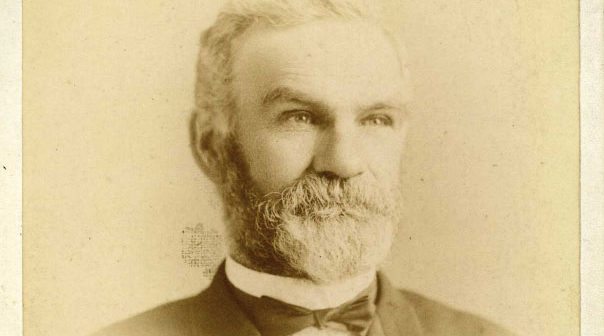By Jane Malone
On Sept. 1, 1919 the people of Adams County celebrated Welcome Home Day for the young men who had returned from service in the international conflict they called the World War. Today, we know it as World War I. The celebration, held in Gettysburg, included a baseball game, two meals for the 400-plus veterans in attendance, concerts by nine local bands, an evening dance, and a parade with a line of march that took an hour to complete.
The cheers for these new veterans were long, loud, and heart felt. The grand marshal of the parade, which snaked its way through Gettysburg’s streets celebrating the return of the newest vets, was one of Adams County’s most celebrated citizens. Theodore McAllister (pictured at right) was known to almost everyone in Adams County. Why did the 1919 Welcome Home Committee select this 78-year-old Civil War veteran to act as grand marshal?
McAllister was one of the boys who left Adams County to fight for the Union in 1861. He enlisted in Company C, First Maryland Cavalry (Cole’s Cavalry) and served with that unit until the war ended in 1865. On May 15, 1864, Sgt. McAllister was wounded in the head and captured by Confederate forces. He was sent to the infamous Andersonville Prison in Georgia where he endured its brutal conditions for seven months before his release. As described by Kendra Debany, owner of Gettysburg House Histories, McAllister was barely recognizable when he returned to Gettysburg in December 1864. His normal weight of about 190 pounds was reduced to 100 pounds, and he could barely walk.
A family friend described a visit McAllister made to his family home early in his recuperation. In a letter to the Gettysburg Times in 1924, C.M. Young said when Theodore arrived at their home, during his convalescence in 1865, it took two men to get McAllister from the buggy and the best McAllister could do was drag himself to a spot on their porch and lay down during the visit. McAllister turned down the offer of a bed. The Youngs listened as McAllister described the depth of the hunger the prisoners at Andersonville experienced. He confessed that “when the inmates became so hungry…they picked up the beans from the offal and ate.”
The desperation of the inmates was made clear when McAllister described what happened when notice of an announced parole was carried out: “. . .the prisoners in the stockade would gather around the entrance and when the name of a soldier was called they would all hold up their hands” hoping to be freed under the name of the lucky parolee. McAllister said he “raised his hand at every name hoping that the name of some fellow who had gone to his rest would be called and he might be selected.” Finally, he was pointed out and walked out of the stockade to the paroling officer and was sent home by train to Gettysburg. McAllister returned to his unit early in 1865 and served as Company C’s color bearer until the end of the war in April of that year.
For the World War veterans who had seen the poison gas, flame throwers, machine guns, tanks, and the new war from the air, McAllister was an inspiration to the ability to survive, endure, and prosper. McAllister returned to Gettysburg in 1868, took up farming, married, and helped raise a family of six children. He continued to serve his country as a member of the Pennsylvania House of Representatives in 1894-95 and volunteered diligently in the Corporal Skelly No. 9 Post of the Grand Army of the Republic until his death in 1924.
McAllister showed the boys of 1917 that life after a brutal war could be happy, productive, prosperous, and filled with service to their fellow citizens.
Jane Malone is a Gettysburg Licensed Town Historian. To learn more, visit www.gblth.com.




